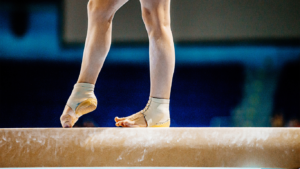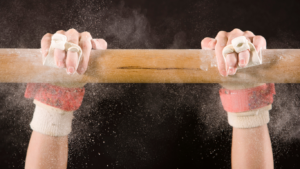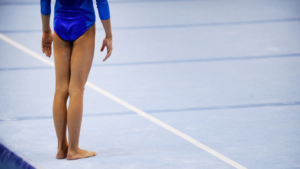Common Injuries in Gymnastics and their treatment
Written by GCPSH Physio Erin Fitzgerald B.Physio{HonsIIA}, M Sport Physio
Gymnastics is a very physically demanding sport requiring participants to generate a great deal of power through wide ranges of joint movements. As such, the pattern and type of injuries that occur tend to be unique to gymnastics and thus require special prevention and management strategies. Below are a selection of three common injuries that occur with gymnastics as well as strategies to prevent them.
 Ankle
Ankle
Ankle injuries are reported as being the most common injury in gymnastics and include sprains, fractures and impingement. Impingement occurs when tissue in the ankle gets pinched and creates pain because of a poorly positioned ankle joint, muscle tightness, joint instability or landing incorrectly from acrobatic skills (landing short). The good news is that ankle impingement can be prevented and treated very effectively by doing the following:-
 – Stretch your calves regularly hold for 30 seconds, 3 times each calf and repeat 3 times within your gym session
– Stretch your calves regularly hold for 30 seconds, 3 times each calf and repeat 3 times within your gym session
– Knee to wall stretch. Gymnasts want more knee to wall range than most other athletes to correctly execute their skills.
– Rolling calf with foam roller in order to loosen tight muscles.
– Taping ankle when increasing tumbling
– Balance exercises will stabilise the ankle. Stand on one leg and try to shut your eyes. How long can you hold it for? Try to hold this position for more than 30seconds. Then make it harder by standing on a soft surface such as trampoline or balance disc.
Lower back
 Gymnastics has a large flexibility requirement, particularly in the low back and lower limbs. Did you know that when your legs are too tight the low back can be affected? Flexibility, particularly in front splits can be adversely affected by growing when the long bones grow and the muscles have to catch up. So it’s actually quite normal to find that you have periods of time when your flexibility drops off. As such It is really important to measure your height every month so when you notice that you are growing you can pay special attention to isolating your stretches and making sure your technique is good particularly in splits, split leaps and arabesque.
Gymnastics has a large flexibility requirement, particularly in the low back and lower limbs. Did you know that when your legs are too tight the low back can be affected? Flexibility, particularly in front splits can be adversely affected by growing when the long bones grow and the muscles have to catch up. So it’s actually quite normal to find that you have periods of time when your flexibility drops off. As such It is really important to measure your height every month so when you notice that you are growing you can pay special attention to isolating your stretches and making sure your technique is good particularly in splits, split leaps and arabesque.
In addition to your gym stretches you can add in some of the following stretches at home:-
-hamstring lying on your back
-hip flexor
-quad
-calf
-foam rolling
-regular massage with a massage therapist that works regularly with gymnastic/dance/acrobat athletes
If you are experiencing lower limb tightness the best thing is to not force the stretch as this can cause stress in the low back. Good technique in your stretches is as important as good technique in your gymnastic skills and should always be the number one priority.
If your front splits are getting worse and you haven’t grown in the past few months it could be the first sign that you have a back problem which causes tightening in the sciatic nerve that runs down the back of your leg. If this is the case then it’s a good time to see a Sports Physio to see the actual cause of your lack of flexibility. The back can be aggravated in gymnastics from poor flexibility, poor core stability, increased tumbling, increased dismounts, changes in strength and conditioning or poor technique. It’s always important to tell your coach if your back is getting tight so together you can pin-point what the problem is.
When your core is weak more stress goes through your back causing back pain over time. One of the reasons gymnasts need to do so much strength and conditioning is to stabilise the back properly when doing acrobatic and dynamic skills – the stronger you are the less likely you will have pain!
As well as the above stretches you can help prevent back pain by working on your core:-
-Dishes
-Leg lifts
-Leg lowers are all good core exercises that keep you strong for gymnastics.
-PILATES based exercises with a qualified instructor
Elbows
Elbows in gymnasts take a lot of strain because of the increased weight bearing while performing handstands, tumbling or doing strength and conditioning. Any moderate to severe elbow pain and/or limitation of movement that comes on by itself persisting beyond 1-2 weeks, requires a visit to the Sports Physio for assessment because of the prevalence of the condition Osteochondritis Dissecans (OCD) in gymnasts. OCD is a condition affecting the elbow where repetitive strain can cause damage to the blood vessels and joint surface of the elbow. It typically affects adolescents between the ages of 12 and 15 and can result in early retirement. The good news is that if caught early it can be treated quite effectively. Treatment involves rests, control of inflammation, mobilisation and exercises to regain range of motion in the elbow and most importantly stability training of the upper limbs so the weight is being taken evenly and correctly through the arms.
There are things that you can do at home that may assist in preventing the condition:-
-Stretching the upper back (thoracic spine) with a foam roller or two tennis balls taped together. This will help to open up the shoulders in handstand position
-Stretch your shoulders including triceps and back of shoulder to make sure the shoulder position is correct in handstand position
-Listen to your coaches and work hard to improve your technique with handstands because this will result in less strain through the elbows
-Stretch your arms regularly
These are just a few of the common injuries that can happen in gymnastics. Please stand by for more information in upcoming newsletters.
Remember that regular massage along with stretching and strengthening and practicing good technique can prevent many injuries but if pain occurs, early diagnosis and management from a Sports Physio- and especially one who works regularly with Gymnasts- can speed up your recovery time.
Our Physios are available for consult and to make an appointment call us on 07 5500 6470 or book online

































